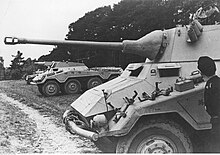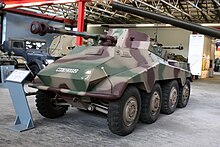|
Sd.Kfz. 234
The Sd.Kfz. 234 (Sonderkraftfahrzeug 234, Special Purpose Vehicle 234), was a family of armoured cars designed and built in Germany during World War II. The vehicles were lightly armoured, armed with a 20, 50 or 75 mm main gun, and powered by a Tatra V12 diesel engine.[3] The Sd.Kfz. 234 broadly resembles the appearance of Sd.Kfz. 231 (8 rad).[2] DevelopmentArmoured wheeled vehicles were developed early in Germany after the end of World War I, since they were not subject to the restrictions of the Versailles Treaty. The Sd.Kfz. 234 belonged to the ARK series (type designation of the chassis) and was the successor to the earlier Sd.Kfz. 231/232/233 (8-Rad), which belonged to the GS series. The combat experience of fast-moving, hard-hitting wheeled reconnaissance vehicles during the Wehrmacht's early invasions of Poland and France impressed German military officials, but indicated some deficiencies in existing designs. A new armoured car project was thus undertaken in August 1940, incorporating several lessons from the Wehrmacht's own external operations.[4] The latest Büssing-NAG Sd.Kfz. 232 variant, the Sd.Kfz. 234 was designed later that year.[5] It was to have a monocoque chassis with eight wheels, and an air-cooled engine for use in North Africa.[5] Chassis were built by Büssing-NAG in Leipzig-Wahren, while armoured bodies were provided by Deutsche Edelstahlwerke of Krefeld and turrets by Daimler Benz in Berlin-Marienfelde and Schichau of Elbing, with engines from Ringhoffer-Tatra-Werke AG of Nesselsdorf.[5]   The first trials with the prototype started around July, 1942. Due to problems with the excessive noise of the first engine, a second model was developed, the Tatra 103. The vehicle had eight-wheel steering and was able to quickly change direction thanks to a second, rear-facing, driver's seat; the transmission had six forward and reverse gears, with traction over the eight wheels. Power was provided by an air-cooled Tatra 103 diesel engine. The Sd.Kfz. 234 was the first and only German armoured vehicle to use an air cooled diesel engine. This was originally intended as a temporary solution until the engine could be redesigned to function better in harsher tropical climates, however, this never happened and thus the Tatra 103 was used until the end of production. The first and possibly best known version was the Sd.Kfz. 234/2; it had a turret armed with a 5 cm L/60 gun, which was originally intended for the VK 1602 Leopard light tank. It was produced from late 1943 to mid 1944. This variant was replaced in production by the second version, the Sd.Kfz. 234/1, which had a simpler open turret (Hängelafette 38)[6] armed with a 2 cm KwK 38 gun; it was manufactured from mid 1944 to early 1945.  The Sd.Kfz. 234/3, produced simultaneously with the 234/1, served as a support vehicle for the reconnaissance vehicles. It had an open-topped superstructure, in which a short-barreled 7.5 cm K51 L/24 gun was installed. This gun was intended for use against "soft" targets; however, when using a hollow charge shell, the penetration power exceeded that of the 5 cm L/60 gun. This variant was produced from mid 1944 to the end of 1944, before switching production to the 234/4. The final variant produced was the Sd.Kfz. 234/4, which replaced the L/24 gun with the 7.5 cm L/46 PaK 40. This was yet another attempt to increase the mobility of this anti-tank gun; however, the 234 chassis was stretched to its limits. This variant was manufactured from the end of 1944 to the end of hostilities in 1945. Service history
Protracted engine development meant that the desert campaign was over before the 234 arrived, but it nevertheless proved useful on the Eastern and Western Fronts.[5] It was quite formidable, but not many were built before it was replaced by the simpler 234/1, with a 20mm gun, in 1944.[7] The Sd.Kfz. 234 was commonly used in pairs, one equipped with a long-range radio communications kit while the other possessed only a short-range radio. The long-range unit was identifiable by the large "star" antenna on the left side of the vehicle. Some sources suggest that the Sd.Kfz. 234/2 was used by the following combat units:[8]
Variants   There were four main variants:
References
Wikimedia Commons has media related to Sonderkraftfahrzeug 234. Sources
Further reading
|
||||||||||||||||||||||||||||||||||||||||||||

